Type i alveolar cells - Study guides, Class notes & Summaries
Looking for the best study guides, study notes and summaries about Type i alveolar cells? On this page you'll find 1653 study documents about Type i alveolar cells.
Page 3 out of 1.653 results
Sort by
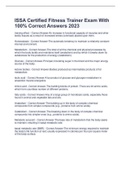
-
ISSA Certified Fitness Trainer Exam With 100% Correct Answers 2023
- Exam (elaborations) • 22 pages • 2023
-
Available in package deal
-
- $15.49
- 1x sold
- + learn more
training effect - Correct Answer-An increase in functional capacity of muscles and other bodily tissues as a result of increased stress (overload) placed upon them. Homeostasis - Correct Answer-The automatic tendency to maintain a relatively constant internal environment. Metabolism - Correct Answer-The total of all the chemical and physical processes by which the body builds and maintains itself (anabolism) and by which it breaks down its substances for the production of energy (catabolis...
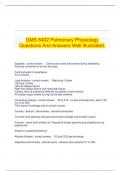
-
GMS 6402 Pulmonary Physiology Questions And Answers Well Illustrated.
- Exam (elaborations) • 27 pages • 2024
-
- $12.99
- + learn more
GMS 6402 Pulmonary Physiology Questions And Answers Well Illustrated. Epiglottis - correct answer. Covers local cords and trachea during swallowing Prevents movement of air into the lungs Food and water to esophagus Air to trachea Lung Anatomy - correct answer. Right lung: 3 lobes Left lung: 2 lobes Left has oblique fissure Right has oblique fissure and Horizontal fissure Cardiac notch is anatomical hallmark for position of left ventricle All cardiac output travels ...
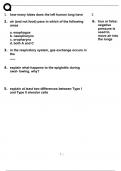
-
BIOD 151 module 2 exam Portage learning WINTER 2024
- Exam (elaborations) • 9 pages • 2024
-
- $20.49
- + learn more
how many lobes does the left human lung have 2 2. air (and not food) pass in which of the following areas a. esophagus b. nasopharynx c. oropharynx d. both A and C nasopharynx 3. in the respiratory system, gas exchange occurs in the ___ respiratory bronchioles and pulmonary alveoli 4. explain what happens to the epiglottis during swallowing. why? epiglottis moves inferiorly to cover the trachea to prevent food/liquid from entering lungs 5. explain at least two differences between T...
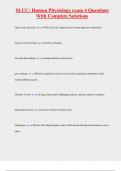
-
SLCC: Human Physiology exam 4 Questions With Complete Solutions
- Exam (elaborations) • 26 pages • 2024
- Available in package deal
-
- $20.99
- + learn more
SLCC: Human Physiology exam 4 Questions With Complete Solutions Type I cells (alveolar) Wall of alveoli, single layer of simple squamous epithelium Type II cells (alveolar) Secrete surfactant Alveolar Macrophage immune defense in the alveoli gas exchange Blood in capillaries meets air in alveoli at respiratory membrane where simple diffusion occurs Thoracic Cavity rib cage, intercostals, diaphragm, pleura, sternum, thoracic vertebrae Intercostal muscles Increase volume of chest cavity
![NURS 223: Exam 2 [Chapters 18, 35-40, 48-49] All Solved Correctly. (2024)](/docpics/3950186/656b8f36f112a_3950186_121_171.jpeg)
-
NURS 223: Exam 2 [Chapters 18, 35-40, 48-49] All Solved Correctly. (2024)
- Exam (elaborations) • 71 pages • 2023
-
Available in package deal
-
- $15.49
- + learn more
The nurse and nursing student are assessing a client experiencing shock. The nurse teaches the student that which of these findings reflects compensatory sympathetic stimulation in a shock state? a) decrease in the serum creatinine b) overgrowth of the glomerular basement membrane c) increase in thyroid hormone production d) decreased urine output correct answers d) decreased urine output During periods of strong sympathetic stimulation, such as shock, constriction of the afferent ar...
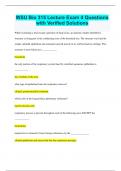
-
WSU Bio 315 Lecture Exam 4 Questions with Verified Solutions
- Exam (elaborations) • 10 pages • 2024
-
Available in package deal
-
- $9.99
- + learn more
WSU Bio 315 Lecture Exam 4 Questions with Verified Solutions While examining a microscopic specimen of lung tissue, an anatomy student identified a structure as being part of the conducting zone of the bronchial tree. The structure was lined by simple cuboidal epithelium and contained smooth muscle in its wall but had no cartilage. This structure is most likely a(n) ____________ bronchiole the only portion of the respiratory system lined by stratified squamous epithelium is _________...

-
Bios 255 Final exam review
- Exam (elaborations) • 32 pages • 2024
-
- $11.99
- + learn more
Be familiar with left and right sided heart failure and what the consequences are (remember the case study that we did in lecture and lab?) (698) Left side: One cause of mitral insufficiency, in which there is backflow of blood from the left ventricle into the left atrium, is mitral valve prolapse (MVP). In MVP one or both cusps of the mitral valve protrude into the left atrium during ventricular contraction. Mitral valve prolapse is one of the most common valvular disorders, affecting as much ...
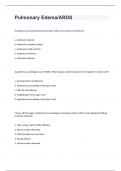
-
Pulmonary Edema/ARDS verified already passed 2024
- Exam (elaborations) • 13 pages • 2024
- Available in package deal
-
- $16.99
- + learn more
Pulmonary Edema/ARDS A patient has a decreased oncotic pressure. What can be done to increase it? a. Administer albumin b. Administer morphine sulfate c. Implement a high-salt diet d. Administer milrinone a. Administer albumin A patient has a prolonged case of ARDS. What changes would be expected in the patient's alveolar cells? a. Development of emphysema b. Hyperplasia and swelling of the type II cells c. Influx of macrophages d. Multiplication of the type I cells b. Hyper...
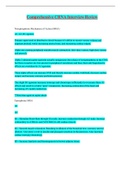
-
Comprehensive CRNA Interview Review Accurate responses are given.
- Presentation • 70 pages • 2023
-
- $18.99
- 3x sold
- + learn more
Comprehensive CRNA Interview Review Accurate responses are given. Comprehensive CRNA Interview Review Norepinephrine Mechanism of Action (MOA) A1, A2, B1 agonist. Primary agent used in distributive shock because it's ability to recruit venous volume and augment preload, while increasing arterial tone, and increasing cardiac output. Alpha one causing peripheral smooth muscle contraction. (low dose venous, high dose venous and arterial). Alpha 2 adrenoreceptor agonism actually ant...
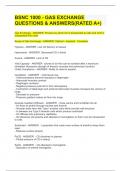
-
BSNC 1000 - GAS EXCHANGE QUESTIONS & ANSWERS(RATED A+)
- Exam (elaborations) • 8 pages • 2024
- Available in package deal
-
- $11.99
- + learn more
Gas Exchange - ANSWER Process by which O2 is transported to cells and CO2 is transported from cells Scope of Gas Exchange - ANSWER Optimal - Impaired - Cessation Hypoxia - ANSWER Low O2 delivery to tissues Hypoxemia - ANSWER Decreased O2 in blood Anoxia - ANSWER Lack of O2 Vital Capacity - ANSWER volume of air that can be exhaled after a maximum inhalation (Assesses strength of thoracic muscles and pulmonary function) Chest Compliance - ANSWER Ability of chest to expand ...

Do you wonder why so many students wear nice clothes, have money to spare and enjoy tons of free time? Well, they sell on Stuvia! Imagine your study notes being downloaded a dozen times for $15 each. Every. Single. Day. Discover all about earning on Stuvia


